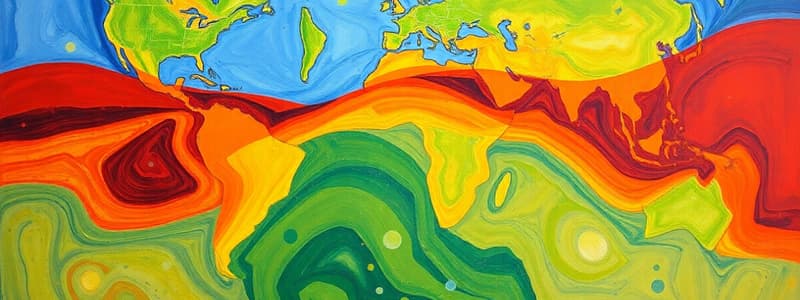Podcast
Questions and Answers
Which observation did NOT contribute to the development of the theory of plate tectonics?
Which observation did NOT contribute to the development of the theory of plate tectonics?
- Changes in atmospheric pressure over time (correct)
- Matching fossil evidence on different continents.
- Distribution of earthquakes along specific zones.
- Similarity of rock formations across continents.
Wegener's theory of continental drift was immediately accepted by the scientific community due to the compelling evidence he presented.
Wegener's theory of continental drift was immediately accepted by the scientific community due to the compelling evidence he presented.
False (B)
Describe how magnetic striping on the ocean floor supports the theory of seafloor spreading.
Describe how magnetic striping on the ocean floor supports the theory of seafloor spreading.
Magnetic striping provides a record of Earth's magnetic field reversals, which are symmetrical on either side of mid-ocean ridges, indicating new crust is formed and then moves away from the ridge.
The Earth's lithosphere is divided into several large ______ that move slowly over the asthenosphere.
The Earth's lithosphere is divided into several large ______ that move slowly over the asthenosphere.
Match the following pieces of evidence with the specific aspect of plate tectonics they support:
Match the following pieces of evidence with the specific aspect of plate tectonics they support:
Which of the following best describes the driving force behind plate tectonics?
Which of the following best describes the driving force behind plate tectonics?
During seafloor spreading, what happens to the older crust as new magma emerges and solidifies?
During seafloor spreading, what happens to the older crust as new magma emerges and solidifies?
Explain the relationship between temperature, density, and movement in the context of plate tectonics.
Explain the relationship between temperature, density, and movement in the context of plate tectonics.
Flashcards
Plate Tectonics
Plate Tectonics
The theory that Earth's lithosphere is divided into moving plates over the asthenosphere.
Evidence: Earthquakes
Evidence: Earthquakes
Seismic events occur where tectonic plates interact, indicating their movement.
Evidence: Mid-Ocean Ridges
Evidence: Mid-Ocean Ridges
Underwater ridges where new ocean floor is created by seafloor spreading.
Evidence: Fossils
Evidence: Fossils
Signup and view all the flashcards
Continental Drift (Wegener)
Continental Drift (Wegener)
Signup and view all the flashcards
Seafloor Spreading Process
Seafloor Spreading Process
Signup and view all the flashcards
Convection Currents
Convection Currents
Signup and view all the flashcards
Magnetic Striping
Magnetic Striping
Signup and view all the flashcards
Study Notes
Plate Tectonics
- Plate tectonics is a theory that describes how Earth's lithosphere (the rigid outermost shell) is divided into a number of plates that move relative to each other.
- Continental drift was the idea that continents had once been part of a single landmass and had drifted apart (wegener’s theory).
Evidence supporting Plate Tectonics
- Fossil evidence: Similar fossils found on different continents.
- Rock type evidence: Similar rock types and mountain ranges found on different continents.
- Matching coastlines: The shapes of continents appear to fit together like puzzle pieces.
- Paleoclimatic evidence: Evidence of past climates, preserved in rocks, suggests past positions of continents.
- Earthquakes and volcanoes: Earthquakes and volcanoes are often found along plate boundaries.
Continental Drift
- Wegner proposed the hypothesis of continental drift, suggesting the continents had once been joined together in a supercontinent called Pangaea.
- However, Wegner's theory lacked a convincing mechanism to explain how continents moved.
Seafloor Spreading
- Seafloor spreading is a process where new oceanic crust forms along mid-ocean ridges and spreads outwards away from the ridges.
- Magma rises from the Earth's mantle to fill the gap created by the spreading plates.
- The cooled magma creates new crust, while older crust is pushed away.
Plate Movement
- Convection currents in the Earth's mantle are thought to cause the movement of tectonic plates.
- Hot material rises, cools, and sinks, creating cyclical motions that pull the plates.
- Differences in density between layers also play a part.
- The movement of plates causes interaction/changes that affect the features of the Earth's surface. For example the formation of mountain ranges, volcanoes, and earthquakes.
Studying That Suits You
Use AI to generate personalized quizzes and flashcards to suit your learning preferences.




